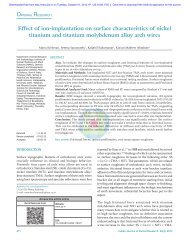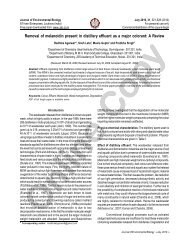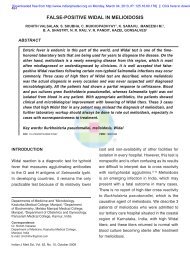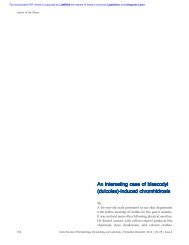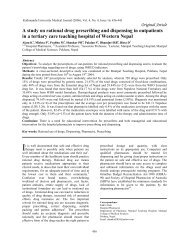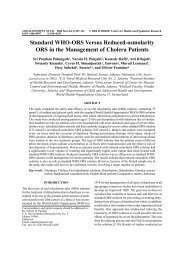Simultaneous Detection of Strychnine and Brucine in Biological ...
Simultaneous Detection of Strychnine and Brucine in Biological ...
Simultaneous Detection of Strychnine and Brucine in Biological ...
Create successful ePaper yourself
Turn your PDF publications into a flip-book with our unique Google optimized e-Paper software.
20 JOURNAL OF THE INDIAN SOCIETY OF TOXICOLOGY (JIST) VOL 006 ISSUE 001 JAN-JUN 2 010<br />
Ltd. Visceral exhibits <strong>of</strong> stomach, <strong>in</strong>test<strong>in</strong>e, liver, spleen,<br />
kidney, blood, <strong>and</strong> sp<strong>in</strong>al cord sent by the forensic pathologist<br />
constituted the biological matrices, while other<br />
crime scene exhibits <strong>in</strong>cluded a steel vessel, a sieve for<br />
filter<strong>in</strong>g, <strong>and</strong> a polythene milk packet.<br />
Apparatus: The follow<strong>in</strong>g equipment was used for the<br />
study -<br />
St<strong>and</strong>ard TLC apparatus from E-Merck<br />
Gas chromatograph-Mass spectrometer, Perk<strong>in</strong> Elmer<br />
GC Model: Perk<strong>in</strong> Elmer<br />
MS Model: PE-Turbo Matrix.<br />
S<strong>of</strong>tware: Turbo Mass.<br />
Preparation <strong>of</strong> St<strong>and</strong>ard Solution: St<strong>and</strong>ard solution<br />
<strong>of</strong> strychn<strong>in</strong>e <strong>and</strong> bruc<strong>in</strong>e was prepared by dissolv<strong>in</strong>g<br />
10mg each <strong>in</strong> 10 ml pure methanol to obta<strong>in</strong> a concentration<br />
<strong>of</strong> 1mg/ml.<br />
Extraction from <strong>Biological</strong> Matrices: The method<br />
used for the extraction was basically from the work<strong>in</strong>g<br />
manual <strong>of</strong> the Directorate <strong>of</strong> Forensic Science (DFS),<br />
New Delhi, with m<strong>in</strong>or modifications to suit the nature<br />
<strong>and</strong> quantity <strong>of</strong> the exhibit. 5<br />
50 gm <strong>of</strong> macerated tissue <strong>of</strong> stomach <strong>and</strong> <strong>in</strong>test<strong>in</strong>e was<br />
mixed with 50 ml <strong>of</strong> rectified spirit <strong>in</strong> a conical flask <strong>and</strong><br />
acidified with tartaric acid. The conical flask was heated<br />
on the water bath for about 1 hour. The resultant mixture<br />
was then filtered through a filter paper. The filtrate<br />
was evaporated <strong>and</strong> the residue added to 50 ml <strong>of</strong> warm<br />
distilled water <strong>and</strong> filtered through a Whatman filter paper.<br />
The filtrate was transferred to a separat<strong>in</strong>g funnel<br />
<strong>and</strong> rendered alkal<strong>in</strong>e with ammonia solution, <strong>and</strong> extracted<br />
with a diethyl ether solvent, <strong>in</strong> portions <strong>of</strong> about<br />
25 ml at each extraction for three times. The extract<br />
was purified by dissolv<strong>in</strong>g it <strong>in</strong> about 20 ml <strong>of</strong> water acidulated<br />
with dilute sulphuric acid <strong>and</strong> filter<strong>in</strong>g through a<br />
Whatman filter paper. The filtrate was extracted with<br />
diethyl ether solvent <strong>in</strong> portions <strong>of</strong> 25ml at each extraction<br />
for three times. These extracts were evaporated to<br />
dryness for analysis.<br />
From the above extract, after the extraction procedure,<br />
the follow<strong>in</strong>g colour test was performed as per the DFS<br />
work<strong>in</strong>g procedure manual. The results are mentioned <strong>in</strong><br />
Table 1.<br />
TLC Conditions:<br />
Solvent System: Cyclohexane: Toluene: Diethyl am<strong>in</strong>e<br />
(75:15:10)<br />
Plate: Silica gel G (0.2 mm thickness)<br />
Development: Ascend<strong>in</strong>g technique.<br />
Spray reagent: Dragendorff's Reagent<br />
Colour <strong>of</strong> spot: Orange<br />
Gas Chromatographic Conditions:<br />
Column: Capillary column packed with 5% methyl phenyl<br />
silicone.<br />
Length: 30 mts, <strong>in</strong>ternal diameter 0.25mm.<br />
Carrier gas: Helium.<br />
Flow rate: 1ml/mt.<br />
Temperature programm<strong>in</strong>g -<br />
Oven temperature: 150C for 1 m<strong>in</strong>, Ramp1-9C degree/<br />
m<strong>in</strong> to 280C hold for 8 m<strong>in</strong>.<br />
Injector temperature: 150C.<br />
Temperature <strong>of</strong> <strong>in</strong>terface: 300C<br />
Injection volume: 1microlitre.<br />
Mass Spectroscopy Conditions:<br />
Reagent Gas for Tun<strong>in</strong>g <strong>and</strong> Calibration: Heptacosa<br />
tributyl am<strong>in</strong>e.<br />
Mode: Full scan mode.<br />
Ionization: Electron Impact ionization.<br />
Source Temperature: 250C.<br />
Interface Temperature: 250C.<br />
Results <strong>and</strong> Discussion<br />
For the detection <strong>of</strong> the two nux vomica alkaloids (strychn<strong>in</strong>e<br />
<strong>and</strong> bruc<strong>in</strong>e), TLC <strong>and</strong> colour test were performed<br />
as per st<strong>and</strong>ard procedure. The observations are given<br />
<strong>in</strong> Table 1. The observations <strong>of</strong> Rf values perta<strong>in</strong><strong>in</strong>g to<br />
TLC, <strong>and</strong> the results <strong>of</strong> the colour test <strong>in</strong>dicate the positive<br />
presence <strong>of</strong> the alkaloids <strong>in</strong> all the exhibits.<br />
Fig 1 shows the total ion chromatogram <strong>of</strong> the strychn<strong>in</strong>e<br />
<strong>and</strong> bruc<strong>in</strong>e st<strong>and</strong>ards, while Fig 2 shows the total<br />
ion chromatogram <strong>of</strong> the exhibit. TLC shows well resolved<br />
chromatographic peaks, both <strong>in</strong> the st<strong>and</strong>ards as<br />
well as exhibits, which are not generally achieved with<br />
the conventional method. Experimental condition retention<br />
time <strong>of</strong> strychn<strong>in</strong>e st<strong>and</strong>ards were found to be 12.08,<br />
15.04 respectively. However, the retention time <strong>of</strong> the<br />
two correspond<strong>in</strong>g peaks <strong>in</strong> the exhibits were found to<br />
be match<strong>in</strong>g (Table 2).



